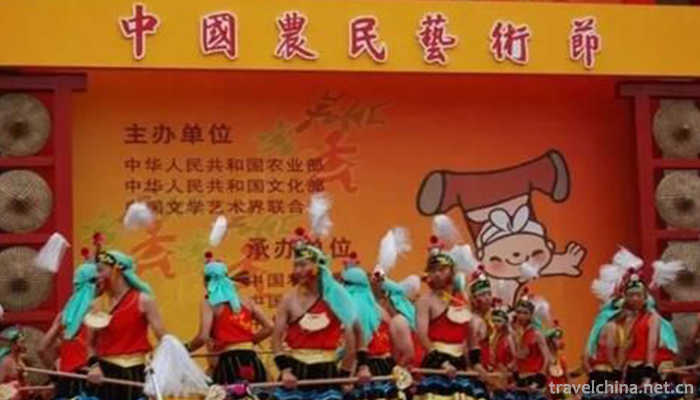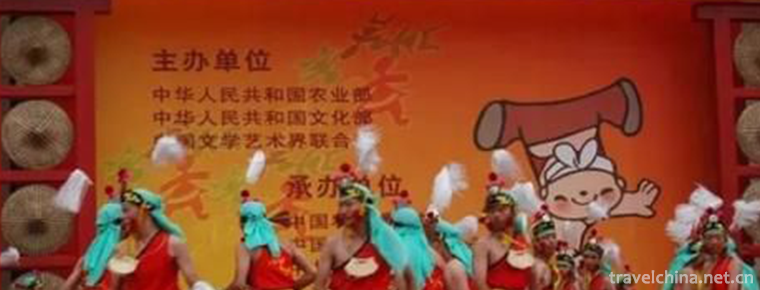Horse vaulting
Horse vaulting
Horse vaulting, a traditional sacrificial dance, is popular in Rudong, Jiangsu Province. It is a dance performed in sacrificing the "Dutian King" they believe in. Participants held "horse cuttings" (long needles) to symbolize "stakes" and hung "horse bells" on their harnesses. They compared themselves to "horses" serving God. They kept beating their feet and clanging the bells as they marched, in order to pray for God's protection. On the Birthday of Dutianwang, the villagers took Dutianwang's God-driven (sedan chair with God statue) on a tour, and the people who participated in the "vaulting horse man" always danced with God-driven before and after. Similar dynamics such as burden-bearing, boating and Net-casting often appeared in the dance, which showed the nature of fishermen, salt people and coastal peasants. Now, there is no such activities as the meeting for gods. The "vaulting horse" has been transformed from the worship of gods to the form of men's dance. The "horse cuttings" and "horse bells" have also become props for the dance.
On May 23, 2011, the vault was listed in the third batch of national intangible cultural heritage list with the approval of the State Council.
"Horse vaulting" was originally a sacrificial dance spread in Rudong area. The sacrificial God was "Dutian Wang Ye". According to legend, "Dutianwang Ye" was the title of the pursuer of Tang Suzong to Zhang Xun, his general. In October of the second year of Tang to De (757), Zhang Xun (709-757) defended the city of Weiyang (now Shangqiu Nan, Henan Province) against the rebels in Anlu Mountains. In October, all the food was spent. Narrow sparrows dug rats and fed the soldiers with hunger. When the rebels committed another offence, Zhang used his ingenious tactics to tie the sergeant's body to a horse bell and run around the city, making the rebels suspect that the reinforcements have arrived and their souls are in a state of despair. Zhang Xun died because he was outnumbered by others. Later, the court pursued feudalism, and the people built temples and offered sacrifices on their birthdays. During the Ming and Qing Dynasties, Japanese bandits often harassed the coastal areas. Local people placed their hearts on Zhang, recalled the heroes and prayed for the gods to alleviate disasters and reduce blessings. As a result, the worship gradually evolved into "burning horseback incense". This activity lasted until the early 1950s, especially in Dongfengli, Matang and Digging Harbor. In the late 1970s and early 1980s, Rudong folk dance "Horse-vaulting Fu" was included in the "Chinese Folk Dance Integration" and was able to reproduce its splendor. It was performed in Nantong, Nanjing and even in Zhongnanhai, Beijing.
Characteristic
Simple and orderly dancing, clangorous rhythm, rough shouting and even the momentum of overthrowing mountains and shaking the earth are called "Chinese disco" by foreigners. "Horse-dancing" is a group of men dancing, without music accompaniment. It mainly depends on the bell sound worn by the groom. The dance is mobile and changeable. On the stage, rows of rough and tough grooms, with bells, silver pins, red camouflage inlaid on the face of the treasure plate, hand-held horse cuttings, legs wrapped in plain cloth, straw shoes, chest suspension padlock, hollow black sole and short legs, without strabismus, dance in groups; stamp, step, swing, stride, stride, stride, stride, stride, stride, stride, stride, stride, stride, stride, stride, stride, the whole action is tough and powerful. It tells the world a moving story that frightens the enemy with the bell, praises Zhang's fearlessness in driving demons out of town, and places people's good wishes on eliminating disasters and praying for good luck. A long and deep trumpet, a slow and solemn Gong and drum, like thousands of horse bells sounding at the same time, the huge apricot yellow dragon bobbing in the wind, rendering the tragic and stirring of the ancient soldiers fighting in horses, people seem to be in the battlefield of the ancient battle between the two armies. "Ha-ha, ha-ha! Ha-ha, ha-ha!" The roar is louder and louder, and the rhythm is faster and faster. The crowds of horsemen should step with drums and change with gongs. Sometimes the birds go through the woods, sometimes the dragons spit their beards, and the formation changes rapidly. Trumpets, gongs, horse bells, and shouts are loud and earth-shaking. Sometimes they step over and hold up their cuttings as devout sacrifices. Sometimes they jump forward without hesitation. Dragon dance, hula; bell, jingle; cry to suppress the clouds, like a tiger down the hill, like a dragon out of the sea... Suddenly, all kinds of voices stopped abruptly. The whole process of "vaulting horse" ended, and the whole dance was full of martial spirit and fighting atmosphere.
The style of "vaulting horse" can be summarized in eight sentences:
The feet stand like a clock, the legs and arms bend like a bow.
Keep your chest straight and abdomen closed calmly, breathing through Dantian as loose as a fiddle.
Jump, kick, talk and move shoulder slightly.
Steady and unswerving eyes, vigorous, simple and prestigious.
humanity
Rudong actually commemorates Zhang Shicheng with the activity of "Dutianwangyuan". He had come to dig the harbor and smuggle salt at a high profit. Near the harbor, Yang Jiabang led the salt people to fight with the officers and soldiers. Use sole as a big knife to frighten off officers and soldiers. Local folk songs spread: Yang Jiabang, Yang Jiabang, the good courage to burn salt, officers and soldiers to kill, salt people rebellion. Without knives and guns, he took the sole and tied the pole, and drove the officers and soldiers to death. "Whether in memory of Zhang Xun or Zhang Shicheng, they are the memory of heroes, the respect for the spirit of unyielding struggle, and the expectation of praying for heroes, eliminating disasters and reducing blessings. In the dance, the people who play the groom with silver needles are like the warhorses of the King of Heaven. They wear horse bells and the bells ring when dancing. Everyone holds a silver cuttage in his hand, which is called "horse cuttage". The whole dance is full of the spirit of martial arts, with the desire of revering the King of Heaven, and full of strong fighting atmosphere. Nowadays, "vaulting horse" has been sublimated to the symbol of Rudong spirit. For the sake of peace and tranquility, people will persevere and go forward bravely, even if they go through fire and water.
Competition
In 2010, as one of the four performances selected by Jiangsu Province, the square dance of Rudong Horse-vaulting, a intangible cultural heritage of China, was performed by teachers and students in our school. On the morning of June 16, "Rudong Mafu" participated in the performance of the first Chinese Farmers'Art Festival at the Beijing Agricultural Exhibition Hall and won the Golden Spike Award.
In order to organize "Rudong Horse-vaulting" square dance to participate in the first Chinese Farmers'Art Festival, such as the Dongxian Party Committee and the county government allocated special funds. Jiang Xiaojing, deputy county governor, personally took the lead. The agricultural and Industrial Office of the county Party committee, the county Wenguang New Bureau and the County Education Bureau jointly organized the program's training activities. The program has been greatly adapted on the original basis. From June 1 to June 12, under the guidance of director Ren Naigui, "Rudong Mafu" has conducted closed training. During the training, the "groomsmen" did not fear the heat and worked hard. At the first Chinese Peasant Art Festival, they jumped out of the "Rudong Groomsmen" heroism and displayed the "Rudong Groomsmen" style.


-
1.The Museum of the Imperial Palace of Manchukuo
The Museum of the Imperial Palace of “Manchukuo†is located in Guangfubei Road, Kuancheng District, Changchun City. It is a Palace Ruins Museum built on the site of the Puppet Manchu Palac
Time 2018-12-05 -
2.Fujian earth building (Fujian Tulou)
Fujian Tulou is also called "Hakka Tulou" because most of it is built by Fujian Hakka people. Tulou came into being in Song and Yuan Dynasty and matured in the late Ming
Time 2018-12-08 -
3.Island Jinshan Temple
Jinshan Temple, located in the northern part of Qingyun County, Dezhou City, Shandong Province, was built in the Sui Dynasty and flourished in the Tang Dynasty. It is said that the island Jinshan Temp
Time 2019-01-13 -
4.Jiayin Dinosaur National Geopark
Jiayin Dinosaur National Geopark, the first place where dinosaur fossils occurred in China, is named for the dragon. The fossils unearthed here have been packed into 10 dinosaur skeletons.
Time 2019-01-21 -
5.Tibetan calligraphy
Tibetan calligraphy is an important part of Tibetan culture and art. In the seventh century AD, during the Zampson Zangganbu period of Tubo, minister Tunmi Sampuza absorbed the advantages of different
Time 2019-04-05 -
6.Daur Folk Songs
Daur people mainly live in Inner Mongolia Autonomous Region and Heilongjiang Province, and a few live in Tacheng County, Xinjiang. Daur means "pioneer".
Time 2019-04-22 -
7.Throw stones Lock
Throw stones Lock is an ancient martial arts skill item, which originated in the Tang and Song Dynasties. It has been widely circulated among the Hui people in Kaifeng for a long time. During the Qing
Time 2019-05-13 -
8.Mangkang Trichord Dance
Sanxian Dance originated in Quzika Township, Mangkang County, Changdu District. It has the unique charm of simplicity, elegance, melodiousness and ease, and is deeply loved by the masses. Passengers p
Time 2019-05-22 -
9.Bao Zheng Bao Qing Tian
Bao Zheng (999 - July 3, 1062), He Xi Ren. Luzhou Hefei (now) Anhui Hefei Feidong People. Northern Song Dynasty Famous ministers.
Time 2019-09-11 -
10.Qixian Lake
Qixian lake water resort is located in Fuxing Town, Gaoxian County, more than 40 kilometers away from Yibin City. It is the largest mountain water storage Lake in Yibin City, with a water area of 2632 Mu and a total area of more than 50 square kilometers. It was listed as a regional scenic spot in 1988 and approved as the first batch of provincial wetland park by Sichuan Provincial People's Government in 2008.
Time 2020-10-16 -
11.Xiaoxiangling scenic spot
The synonym Xiaoxiangling generally refers to Xiaoxiangling scenic spot
Time 2020-10-16 -
12.The second industry of Panzhihua
In 2018, the total industrial added value of Panzhihua was 69.163 billion yuan, an increase of 7.0%, and its contribution rate to economic growth was 59.7%. At the end of the year, there were 325 Industrial Enterprises above designated size. The production and sales rate
Time 2020-12-14